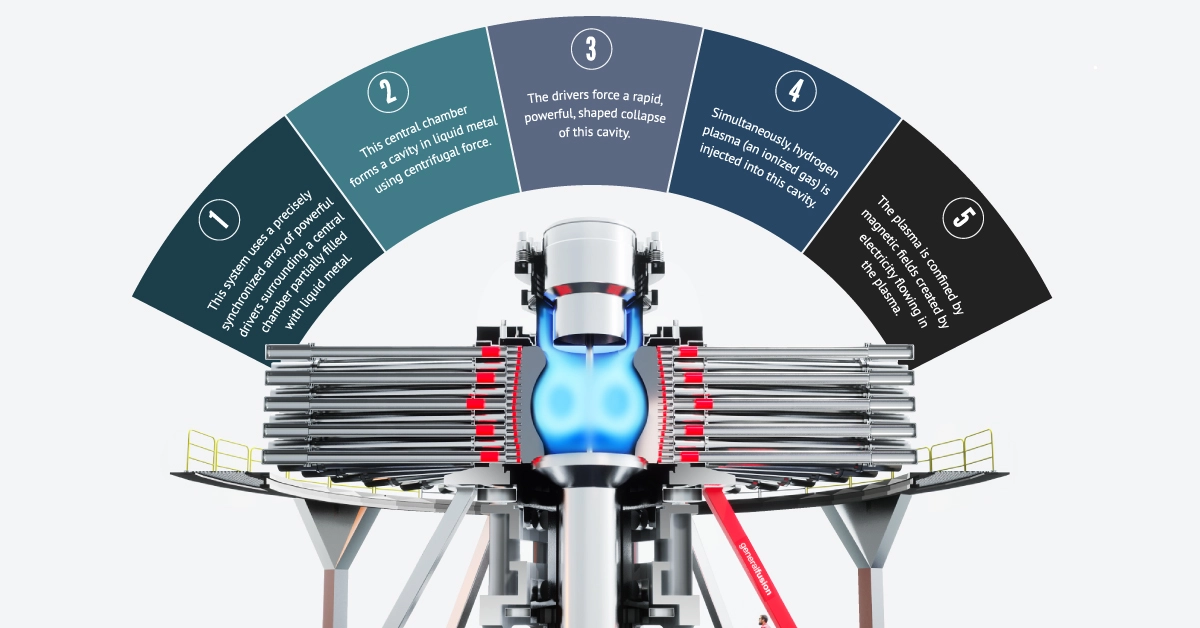ENERGYSPONSORED POSTWhy Fusion Will Power the Race to Net-Zero
WRITTEN BY
Bruno Venditti
GRAPHICS & DESIGN
Miranda Smith
Published October 27, 2022
•
Updated October 27, 2022
•
0 Comments
Tweet
Share
Share
Reddit
Email
The following content is sponsored by General Fusion
General-Fusion_How-Soon-Will-We-Have-Fusion-Power
Why Fusion Will Power the Race to Net Zero
Governments worldwide are targeting massive decreases in carbon emissions by 2050.
With growing populations and high demand for energy, renewable energy sources will be needed to reach a net-zero scenario. However, renewables like wind and solar are intermittent and need a baseload source of clean energy to supplement them.
This infographic from General Fusion explores fusion’s potential to deliver clean, abundant, reliable, and cost-competitive energy.
How Fusion Energy Works
Fusion powers the Sun and the stars, where immense forces compress and heat hydrogen plasma, fusing it into helium and releasing enormous amounts of energy.
Here on Earth, scientists use isotopes of hydrogen—deuterium and tritium—to power fusion plants. Deuterium is abundant in seawater while tritium can be produced from lithium, a common chemical element used in batteries, glass, and ceramics.
In fusion technology, light atomic nuclei are compressed under intense pressure and heat to form heavier ones and release energy. The fuel is heated to about 100 million degrees Celsius. At this hotter-than-the-sun temperature, a fully ionized gas plasma is formed. The plasma is then ignited to create fusion.
Unlike nuclear reactors that split atoms apart, fusion power plants fuse atoms to generate energy. One of the challenges for fusion, however, is to ensure fusion power plants can generate more energy than they consume.
A Sustainable Source of Energy
Fusion is considered one of the safest energy sources since its radiation profile is similar to widely used medical and industrial applications like cyclotrons for cancer treatment.
Fusion power plants have minimal land use and can be built close to cities. They are powered only by hydrogen from water and emit no carbon dioxide or other greenhouse gases.
The amount of deuterium present in one liter of water, for example, can produce as much energy as the combustion of 300 litres of oil, according to the International Atomic Energy Agency. That means there is enough deuterium in the oceans to meet human needs for millions of years.
Besides energy generation, fusion is expected to benefit other markets:
Space propulsion
Marine propulsion
Medical
Off-grid energy
Hydrogen and/or clean fuels
Industrial heat
Fusion Today
In the face of the recent energy crisis, countries—lead by the United States, Russia, China, India, South Korea, Japan, and the nations of the European Union—are investing billions of dollars to harness fusion power. In fact, the White House recently announced a plan to accelerate fusion’s commercial development over the coming decades.
Among the companies that are leading the development of the technology is General Fusion. The Canadian company has built and tested 24 different plasma injectors and, in 2018, commissioned the largest and most powerful plasma injector globally.
After years of refining the power plant, General Fusion is building a first-of-a-kind fusion demonstration facility at the United Kingdom Atomic Energy Authority’s Culham Centre for Fusion Energy.
Once established, fusion power has the potential to provide the kind of baseload energy needed for a sustainable economy.
General Fusion seeks to transform the world’s energy supply with the most practical path to commercial fusion energy. Click here to learn more.






























